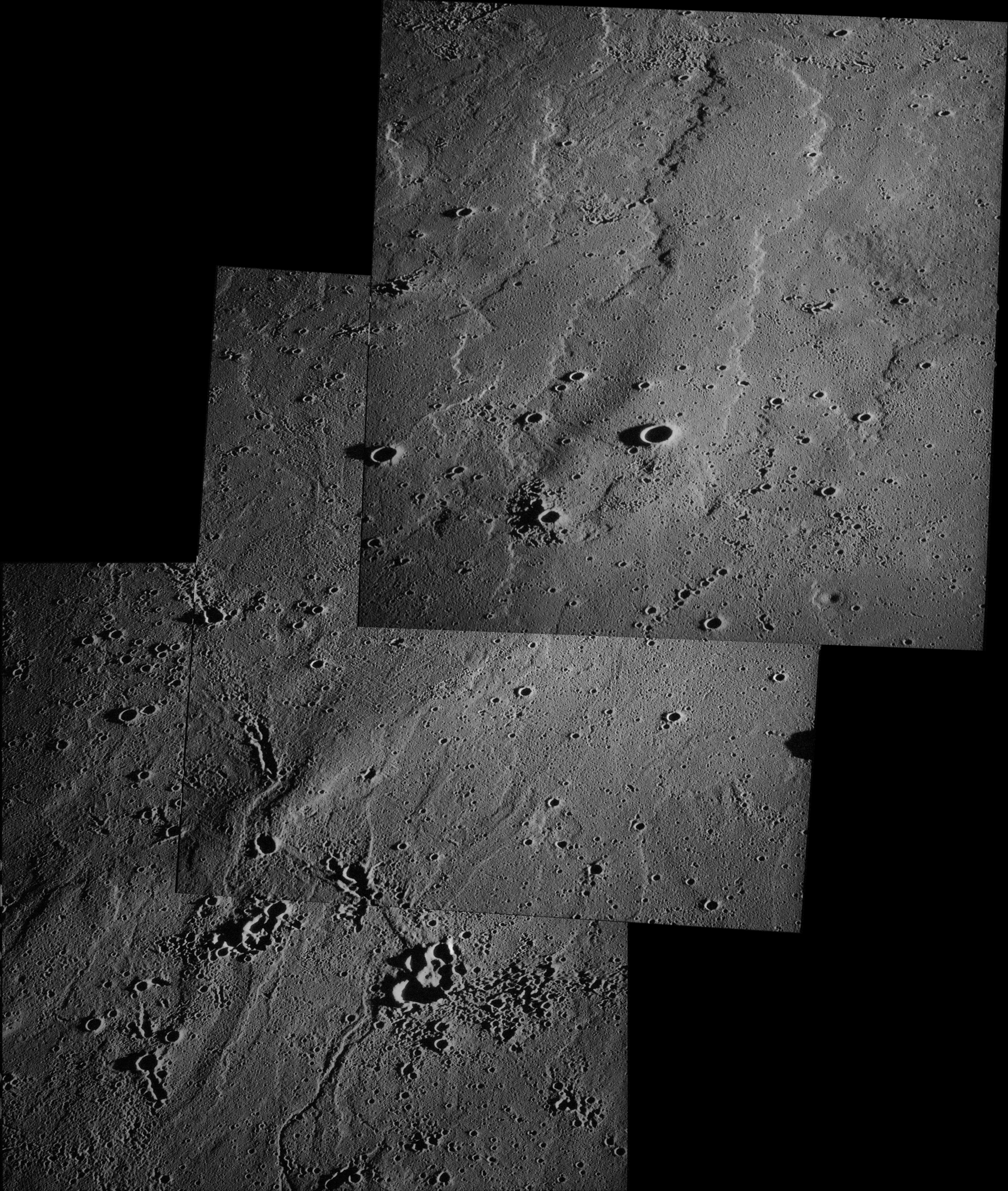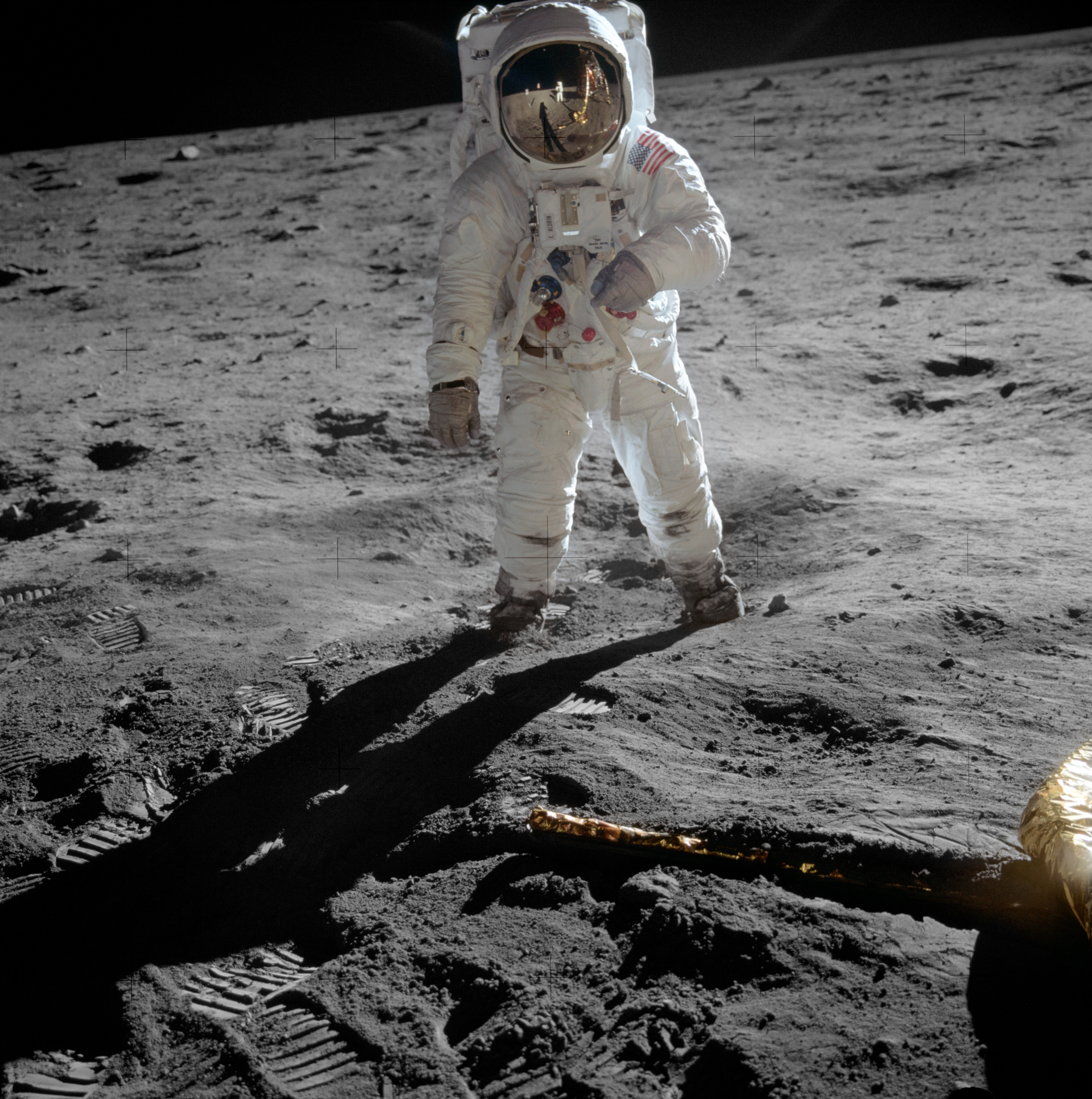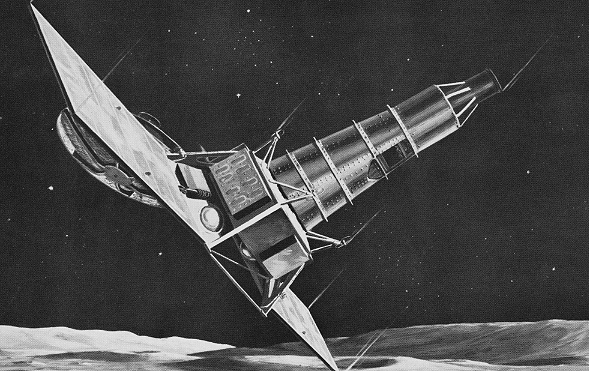|
Alphonsus (crater)
Alphonsus is an ancient impact crater on the Moon that dates from the pre-Nectarian era. (Older sources state that it is Nectarian in age.) It is located on the lunar highlands on the eastern end of Mare Nubium, west of the Imbrian Highlands, and slightly overlaps the crater Ptolemaeus to the north. To the southwest is the smaller Alpetragius. The crater name was approved by the IAU in 1935. Description The surface of Alphonsus is broken and irregular along its boundary with Ptolemaeus. The outer walls are slightly distorted and possess a somewhat hexagonal form. A low ridge system of deposited ejecta bisects the crater floor, and includes the steep central peak designated Alphonsus Alpha (α). This pyramid-shaped formation rises to a height of 1.5 km above the interior surface. It is not volcanic in origin, but rather is made of anorthosite like the lunar highlands. The floor is fractured by an elaborate system of rilles and contains four or five smaller craters ... [...More Info...] [...Related Items...] OR: [Wikipedia] [Google] [Baidu] |
Lunar Reconnaissance Orbiter
The Lunar Reconnaissance Orbiter (LRO) is a NASA robotic spacecraft currently orbiting the Moon in an eccentric Polar orbit, polar mapping orbit. Data collected by LRO have been described as essential for planning NASA's future human and robotic missions to the Moon. Its detailed mapping program is identifying safe landing sites, locating potential resources on the Moon, characterizing the radiation environment, and demonstrating new technologies. Launched on June 18, 2009, in conjunction with the LCROSS, Lunar Crater Observation and Sensing Satellite (LCROSS), as the vanguard of NASA's Lunar Precursor Robotic Program, LRO was the first United States mission to the Moon in over ten years. LRO and LCROSS were launched as part of the United States's Vision for Space Exploration program. The probe has made a 3-D map of the Moon's surface at 100-meter resolution and 98.2% coverage (excluding polar areas in deep shadow), including 0.5-meter resolution images of Apollo landing sites. ... [...More Info...] [...Related Items...] OR: [Wikipedia] [Google] [Baidu] |
Rille
Rille (German for 'groove') is typically used to describe any of the long, narrow depressions in the surface of the Moon that resemble channels. The Latin term is ''rima'', plural ''rimae''. Typically, a rille can be several kilometers wide and hundreds of kilometers in length. However, the term has also been used loosely to describe similar structures on a number of planets in the Solar System, including Mars, Venus, and on a number of moons. All bear a structural resemblance to each other. Structures Three types of rille are found on the lunar surface: * Sinuous rilles meander in a curved path like a mature river, and are commonly thought to be the remains of collapsed lava tubes or extinct lava flows. They usually begin at an extinct volcano, then meander and sometimes split as they are followed across the surface. , 195 sinuous rilles have been identified on the Moon. Vallis Schröteri in Oceanus Procellarum is the largest sinuous rille, and Rima Hadley is the ... [...More Info...] [...Related Items...] OR: [Wikipedia] [Google] [Baidu] |
Transient Lunar Phenomenon
A transient lunar phenomenon (TLP) or lunar transient phenomenon (LTP) is a short-lived change in light, color or appearance on the surface of the Moon. The term was created by Patrick Moore in his co-authorship of NASA Technical Report R-277 ''Chronological Catalog of Reported Lunar Events'', published in 1968. Claims of short-lived lunar phenomena go back at least 1,000 years, with some having been observed independently by multiple witnesses or reputable scientists. Nevertheless, the majority of transient lunar phenomenon reports are Reproducibility, irreproducible and do not possess adequate Experimental control, control experiments that could be used to distinguish among alternative hypotheses to explain their origins. Most lunar scientists will acknowledge that transient events such as outgassing and impact craters, impact cratering do occur over lunar geologic timescale, geologic time. The controversy lies in the frequency of such events. Description of events Reports of ... [...More Info...] [...Related Items...] OR: [Wikipedia] [Google] [Baidu] |
Mare Imbrium
Mare Imbrium (Latin ''imbrium'', the "Sea of Showers" or "Sea of Rains") is a vast lunar mare, lava plain within the Imbrium Basin on the Moon and is one of the larger craters in the Solar System. The Imbrium Basin formed from the collision of a Protoplanet, proto-planet during the Late Heavy Bombardment. Basaltic lava later flooded the giant Impact crater, crater to form the flat volcanic plain seen today. The basin's age has been estimated using Uranium–lead dating, uranium–lead dating methods to approximately 3.9 billion years ago, and the diameter of the impactor has been estimated to be 250 ± 25 km. The Moon's maria (plural of Lunar mare, mare) have fewer features than other areas of the Moon because molten lava pooled in the craters and formed a relatively smooth surface. Mare Imbrium is not as flat as it would have originally been when it first formed as a result of later events that have altered its surface. Origin Mare Imbrium formed when a proto-planet ... [...More Info...] [...Related Items...] OR: [Wikipedia] [Google] [Baidu] |
Gassendi (crater)
Gassendi is a large Lunar craters, lunar impact crater feature located at the northern edge of Mare Humorum. The crater was named after French astronomer Pierre Gassendi by the International Astronomical Union, IAU in 1935. The formation has been inundated by lava during the formation of the Lunar mare, mare, so only the rim and the multiple central peaks remain above the surface. The outer rim is worn and eroded, although it retains a generally circular form. A smaller crater – Gassendi A – intrudes into the northern rim, and joins a rough uplift at the northwest part of the floor. The crater pair bear a curious resemblance to a diamond ring. In the southern part of the crater floor is a semi-circular ridge-like formation that is concentric with the outer rim. It is in the southern part where the rim dips down to its lowest portion, and a gap appears at the most southern point. The rim varies in height from as little as 200 meters to as high as 2.5 kilometers above the sur ... [...More Info...] [...Related Items...] OR: [Wikipedia] [Google] [Baidu] |
Apollo 17
Apollo 17 (December 7–19, 1972) was the eleventh and final mission of NASA's Apollo program, the sixth and most recent time humans have set foot on the Moon. Commander Gene Cernan and Lunar Module Pilot Harrison Schmitt walked on the Moon, while Command Module Pilot Ronald Evans (astronaut), Ronald Evans orbited above. Schmitt was the only professional geologist to land on the Moon; he was selected in place of Joe Engle, as NASA had been under pressure to send a scientist to the Moon. The mission's heavy emphasis on science meant the inclusion of a number of new experiments, including a Fe, Fi, Fo, Fum, and Phooey, biological experiment containing five mice that was carried in the command module. Mission planners had two primary goals in deciding on the landing site: to sample Lunar highlands, lunar highland material older than that at Mare Imbrium and to investigate the possibility of relatively recent Volcano, volcanic activity. They therefore selected Taurus–Littrow, wh ... [...More Info...] [...Related Items...] OR: [Wikipedia] [Google] [Baidu] |
Apollo 16
Apollo 16 (April 1627, 1972) was the tenth human spaceflight, crewed mission in the United States Apollo program, Apollo space program, administered by NASA, and the fifth and penultimate to Moon landing, land on the Moon. It was the second of Apollo's "List of Apollo missions#Alphabetical mission types, J missions", with an extended stay on the Geology of the Moon#Lunar landscape, lunar surface, a focus on science, and the use of the Lunar Roving Vehicle (LRV). The landing and Exploration of the Moon, exploration were in the Descartes Highlands, a site chosen because some scientists expected it to be an area formed by volcanic action, though this proved not to be the case. The mission was crewed by Astronaut ranks and positions, Commander John Young (astronaut), John Young, Lunar Module Pilot Charles Duke and Command Module Pilot Ken Mattingly. Launched from the Kennedy Space Center in Florida on April 16, 1972, Apollo 16 experienced a number of minor glitches en route to the ... [...More Info...] [...Related Items...] OR: [Wikipedia] [Google] [Baidu] |
Xenoliths
A xenolith ("foreign rock") is a rock fragment (country rock) that becomes enveloped in a larger rock during the latter's development and solidification. In geology, the term ''xenolith'' is almost exclusively used to describe inclusions in igneous rock entrained during magma ascent, emplacement and eruption. Xenoliths may be engulfed along the margins of a magma chamber, torn loose from the walls of an erupting lava conduit or explosive diatreme or picked up along the base of a flowing body of lava on the Earth's surface. A xenocryst is an individual foreign crystal included within an igneous body. Examples of xenocrysts are quartz crystals in a silica-deficient lava and diamonds within kimberlite diatremes. Xenoliths can be non-uniform within individual locations, even in areas which are spatially limited, e.g. rhyolite-dominated lava of Niijima volcano (Japan) contains two types of gabbroic xenoliths which are of different origin - they were formed in different temperature an ... [...More Info...] [...Related Items...] OR: [Wikipedia] [Google] [Baidu] |
Apollo Program
The Apollo program, also known as Project Apollo, was the United States human spaceflight program led by NASA, which Moon landing, landed the first humans on the Moon in 1969. Apollo followed Project Mercury that put the first Americans in space. It was conceived in 1960 as a three-person spacecraft during President Presidency of Dwight D. Eisenhower, Dwight D. Eisenhower's administration. Apollo was later dedicated to President John F. Kennedy's national goal for the 1960s of "landing a man on the Moon and returning him safely to the Earth" in an address to United States Congress, Congress on May 25, 1961. It was the third American human spaceflight program to fly, preceded by Project Gemini conceived in 1961 to extend spaceflight capability in support of Apollo. Kennedy's goal was accomplished on the Apollo 11 mission when astronauts Neil Armstrong and Buzz Aldrin landed their Apollo Lunar Module (LM) on July 20, 1969, and walked on the lunar surface, while Michael Collins ( ... [...More Info...] [...Related Items...] OR: [Wikipedia] [Google] [Baidu] |
Harold Urey
Harold Clayton Urey ( ; April 29, 1893 – January 5, 1981) was an American physical chemist whose pioneering work on isotopes earned him the Nobel Prize in Chemistry in 1934 for the discovery of deuterium. He played a significant role in the development of the Nuclear weapon, atom bomb, as well as contributing to theories on the Miller–Urey experiment, development of organic life from non-living matter. Born in Walkerton, Indiana, Urey studied thermodynamics under Gilbert N. Lewis at the University of California, Berkeley. After he received his PhD in 1923, he was awarded a fellowship by the American-Scandinavian Foundation to study at the Niels Bohr Institute in Copenhagen. He was a research associate at Johns Hopkins University before becoming an associate professor of chemistry at Columbia University. In 1931, he began work with the separation of isotopes that resulted in the discovery of deuterium. During World War II, Urey turned his knowledge of isotope separation to ... [...More Info...] [...Related Items...] OR: [Wikipedia] [Google] [Baidu] |
Ranger 9
Ranger 9 was a Lunar probe, launched in 1965 by NASA. It was designed to achieve a lunar impact trajectory and to transmit high-resolution photographs of the lunar surface during the final minutes of flight up to impact. The spacecraft carried six television vidicon cameras—two wide-angle (channel F, cameras A and B) and four narrow-angle (channel P)—to accomplish these objectives. The cameras were arranged in two separate chains, or channels, each self-contained with separate power supplies, timers, and transmitters so as to afford the greatest reliability and probability of obtaining high-quality television pictures. These images were broadcast live on television to millions of viewers across the United States. No other experiments were carried on the spacecraft. Spacecraft design Rangers 6, 7, 8, and 9 were the so-called Block 3 versions of the Ranger spacecraft. The spacecraft consisted of a hexagonal aluminium frame base 1.5 m across on which was mounted the propul ... [...More Info...] [...Related Items...] OR: [Wikipedia] [Google] [Baidu] |










